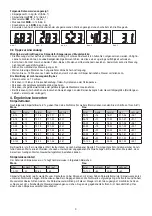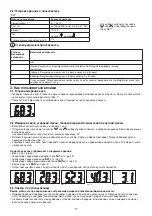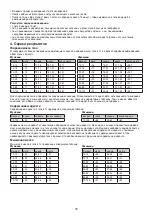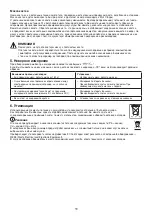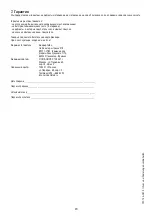
8
4. Evaluation of results
Body fat percentage
The following body fat percentages are guide values (contact your physician for further information).
Man Woman
Age
low
normal
high
very high
Age
low
normal
high
very high
10-14
<11
11-16
16,1-21
>21,1
10-14
<16
16-21
21,1-26
>26,1
15-19
<12
12-17
17,1-22
>22,1
15-19
<17
17-22
22,1-27
>27,1
20-29
<13
13-18
18,1-23
>23,1
20-29
<18
18-23
23,1-28
>28,1
30-39
<14
14-19
19,1-24
>24,1
30-39
<19
19-24
24,1-29
>29,1
40-49
<15
15-20
20,1-25
>25,1
40-49
<20
20-25
25,1-30
>30,1
50-59
<16
16-21
21,1-26
>26,1
50-59
<21
21-26
26,1-31
>31,1
60-69
<17
17-22
22,1-27
>27,1
60-69
<22
22-27
27,1-32
>32,1
70-100
<18
18-23
23,1-28
>28,1
70-100
<23
23-28
28,1-33
>33,1
A lower value is often found in athletes. Depending on the type of sports, training intensity and physical constitution, values may
result which are below the recommended values stated. It should, however, be noted that there could be a danger to health in
the case of extremely low values.
Body water percentage
The body water percentage is normally within the following ranges:
Man Woman
Age
poor
good
very good
Age
low
normal
high
10-100
<50
50-65
>65
10-100
<65
45-60
>60
Body fat contains relatively little water. Therefore persons with a high body fat percentage have body water percentages below
the recommended values. With endurance athletes, however, the recommended values could be exceeded due to low fat per-
centages and high muscle percentage.
This scale is unsuitable for measuring body water in order to draw medical conclusions concerning age-related water retention,
for example. If necessary ask your physician. Basically, a high body water percentage should be the aim.
Muscle percentage
The muscle percentage % is normally within the following ranges:
Man
Woman
Age
low
normal
high
Age
low
normal
high
10-14
<44
44-57
>57
10-14
<36
36-43
>43
15-19
<43
43-56
>56
15-19
<35
35-41
>41
20-29
<42
42-54
>54
20-29
<34
34-39
>39
30-39
<41
41-52
>52
30-39
<33
33-38
>38
40-49
<40
40-50
>50
40-49
<31
31-36
>36
50-59
<39
39-48
>48
50-59
<29
29-34
>34
60-69
<38
38-47
>47
60-69
<28
28-33
>33
70-100
<37
37-46
>46
70-100
<27
27-32
>32
Bone mass
Like the rest of our body, our bones are subject to natural growth, shrinking and ageing processes. The bone mass increases
rapidly during childhood and reaches its peak between the ages of 30 and 40. As we age, our bone mass then begins to red-
uce. You can combat this reduction to an extent with the help of a healthy diet (particularly calcium and vitamin D) and regular
physical exercise. The stability of the skeleton can be further increased by means of targeted muscle build-up. Please note
that this scale does not identify the calcium content of the bones; instead, it calculates the weight of all the components that
make up the bones (organic matter, inorganic matter and water). It is very difficult to influence the bone mass, although it does
fluctuate within the scope of influencing factors (weight, height, age, gender). There are no recognised guidelines or recommen-
dations.
IMPORTANT:
Please do not confuse bone mass with bone density.
The bone density can only be determined by means of a medical examination (e.g. computer tomography, ultrasound).
It is therefore not possible to draw conclusions on changes to bones and bone hardness (e.g. osteoporosis) using this
scale.




